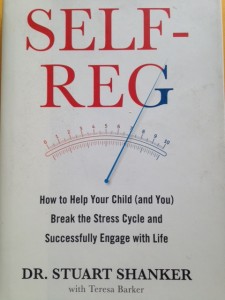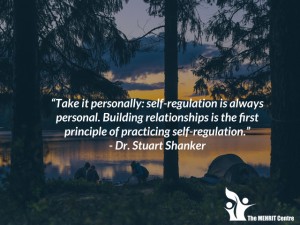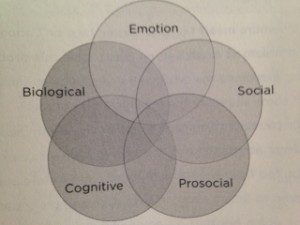Stress Detectives
September 13, 2016 - 8 minutes readReading Dr. Stuart Shanker’s latest book, Self-Reg, not only inspired me, but affirmed the work we are doing throughout West Vancouver Schools. Dr. Shanker, a research professor of psychology and philosophy, has worked with children and parents for many years helping them develop self-regulation skills in each of the five domains – biological, emotional, cognitive, social and prosocial. Since his visit to our district five years ago, his research has had a profound impact on the work we are doing in our schools. At West Bay we have shifted how we view student behaviour, transformed our learning environments, purchased tools and resources, collaborated with experts, and partnered with our parents to align home and school practices. I’d like to think that self-regulation has become ‘West Bay’s State of Mind’!
Shanker’s book provides the scientific explanation as to how the brain responds to stress and why we behave the way we do under certain circumstances. This is helpful for parents and educators whose interactions with youth play a significant role in shaping their behaviour. I learned many years ago as a mother of three how a ‘calm’ demeanour is always the wisest approach in stressful situations such as teaching them how to drive! As I reflect on the last four years at West Bay, several stories come to mind that illustrate how our understanding of self-regulation has changed how we ‘do business’.
Imaad had a difficult time interacting with his peers on the playground, often getting involved in confrontations. He rarely completed his assignments and had challenges sustaining his focus. Through conversations with his mother, I started to appreciate the extent of his sensory stressors. Apparently even the crinkling noise in his pillow at night bothered him. He didn’t like the feeling of his socks against his skin so he wore slip-on shoes or sandals. Noise-cancelling headphones, dim lighting, and quiet zones in the classroom all helped calm Imaad and be a more successful learner. Understanding Imaad’s hypersensitivity to noise, bright light, and textures was key. His teachers and I tried to ‘read the signs and reframe the behaviour’ as Shanker suggests. We became ‘stress detectives’ just like Imaad’s mother had been for many years, making every effort to identify and mitigate the stressors that triggered his frustrations. As seen below, many of our students opt to use headphones to help them focus and reduce extraneous noise in the classroom.
Amanda had a difficult time sitting on the carpet for group lessons, even for short periods of time. Her teacher reported that she would be twirling in the back of the classroom looking very much like a budding ballerina in her own little world. Certainly Amanda was not paying attention to the lesson. On the contrary, Amanda was able to provide insightful comments, right on topic. Amanda needed movement to release tension in her body which helped her be calm and attentive. This particular example illustrates the importance of not making assumptions. What works for one child or ourselves may not work for others. The teacher understood Amanda’s needs and didn’t ask her to return to the carpet – an expectation she might have had prior to her understanding of self-regulation.
At times Teresa experienced difficulty coming to school in the morning, often not able to get out of the car. She couldn’t articulate why she was feeling so uneasy. Her parents and I had discussions about what may be the underlying problem or stressors contributing to Teresa’s anxiety. We implemented a variety of strategies, including parking the car away from West Bay and walking together to school. The most effective strategy, however, was deep belly breathing exercises which helped mitigate her stress levels. Teresa told me she uses this strategy often when she starts to have a ‘nervous tummy’ not only on school days but in other situations. Recognizing the signs of anxiety and taking measures to address these symptoms helped Teresa manage her anxiety. What a great coping strategy to learn at a young age before one’s anxiety becomes a constant barrier throughout life.
According to Shanker, anxiety is always there ‘like a constant hum in the background’ for many children. At West Bay we recognize that at least 20% of our students exhibit signs of anxiety which is why we continue to explore ways to support these children. Teachers use a variety of resources which prompt rich discussion and promote overall well-being.
Each student walking through the school doors has unique needs and comes with a different story – one deserving of our attention. Our goal is to identify stressors, reduce frustrations and bolster self-esteem. Students must also feel supported and not judged for their behaviours. We help these children understand what it feels like to be in a calm state in order to engage successfully at school and in life. Developing relationships and earning trust help students feel emotionally safe and secure at school. Ensuring each child feels a sense of belonging and social connectedness (even just one adult mentor) is immensely important.
Given the interconnectedness of the five domains (see Dr. Shanker’s graphic below), students often experience challenges in more than one domain which is why we value the support of our district’s Self-Regulation team of experts. When we are stumped about the stressors impacting a child, we call upon the team to help us connect the dots. For example, the Occupational Therapist can observe a child and suggest strategies and tools that we may not have considered. Input from the parent (the child’s first teacher) is also invited and valued. As a team we can decide how best to provide the support a child needs.
Our generous parents provide resources and engage willingly in meaningful conversations. Dr. Shanker continues to arm us with the information that we need to be stress detectives in our quest to demystify and understand the root of puzzling behaviours. With this combined level of support, I can proudly say that we have made significant changes to our practice and are making a difference in the lives of many children and their families. Our journey continues.





Recent Comments